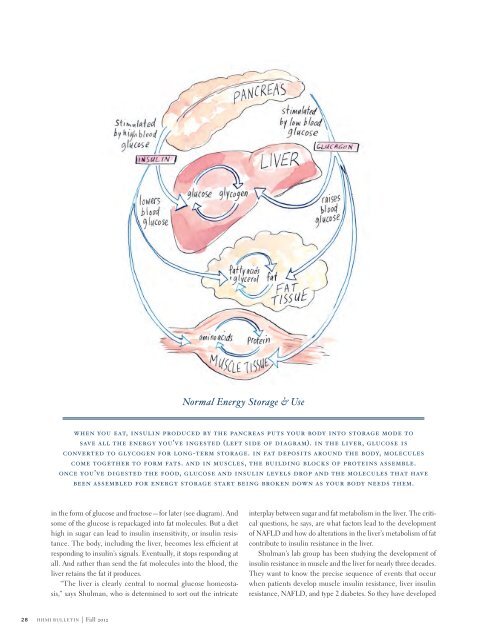Download PDF - Howard Hughes Medical Institute
Download PDF - Howard Hughes Medical Institute
Download PDF - Howard Hughes Medical Institute
Create successful ePaper yourself
Turn your PDF publications into a flip-book with our unique Google optimized e-Paper software.
Normal Energy Storage & Use<br />
when you eat, insulin produced by the pancreas puts your body into storage mode to<br />
save all the energy you’ve ingested (left side of diagram). in the liver, glucose is<br />
converted to glycogen for long-term storage. in fat deposits around the body, molecules<br />
come together to form fats. and in muscles, the building blocks of proteins assemble.<br />
once you’ve digested the food, glucose and insulin levels drop and the molecules that have<br />
been assembled for energy storage start being broken down as your body needs them.<br />
in the form of glucose and fructose—for later (see diagram). And<br />
some of the glucose is repackaged into fat molecules. But a diet<br />
high in sugar can lead to insulin insensitivity, or insulin resistance.<br />
The body, including the liver, becomes less efficient at<br />
responding to insulin’s signals. Eventually, it stops responding at<br />
all. And rather than send the fat molecules into the blood, the<br />
liver retains the fat it produces.<br />
“The liver is clearly central to normal glucose homeostasis,”<br />
says Shulman, who is determined to sort out the intricate<br />
interplay between sugar and fat metabolism in the liver. The critical<br />
questions, he says, are what factors lead to the development<br />
of NAFLD and how do alterations in the liver’s metabolism of fat<br />
contribute to insulin resistance in the liver.<br />
Shulman’s lab group has been studying the development of<br />
insulin resistance in muscle and the liver for nearly three decades.<br />
They want to know the precise sequence of events that occur<br />
when patients develop muscle insulin resistance, liver insulin<br />
resistance, NAFLD, and type 2 diabetes. So they have developed<br />
28 h h m i b u l l e t i n | Fall 2o12
















